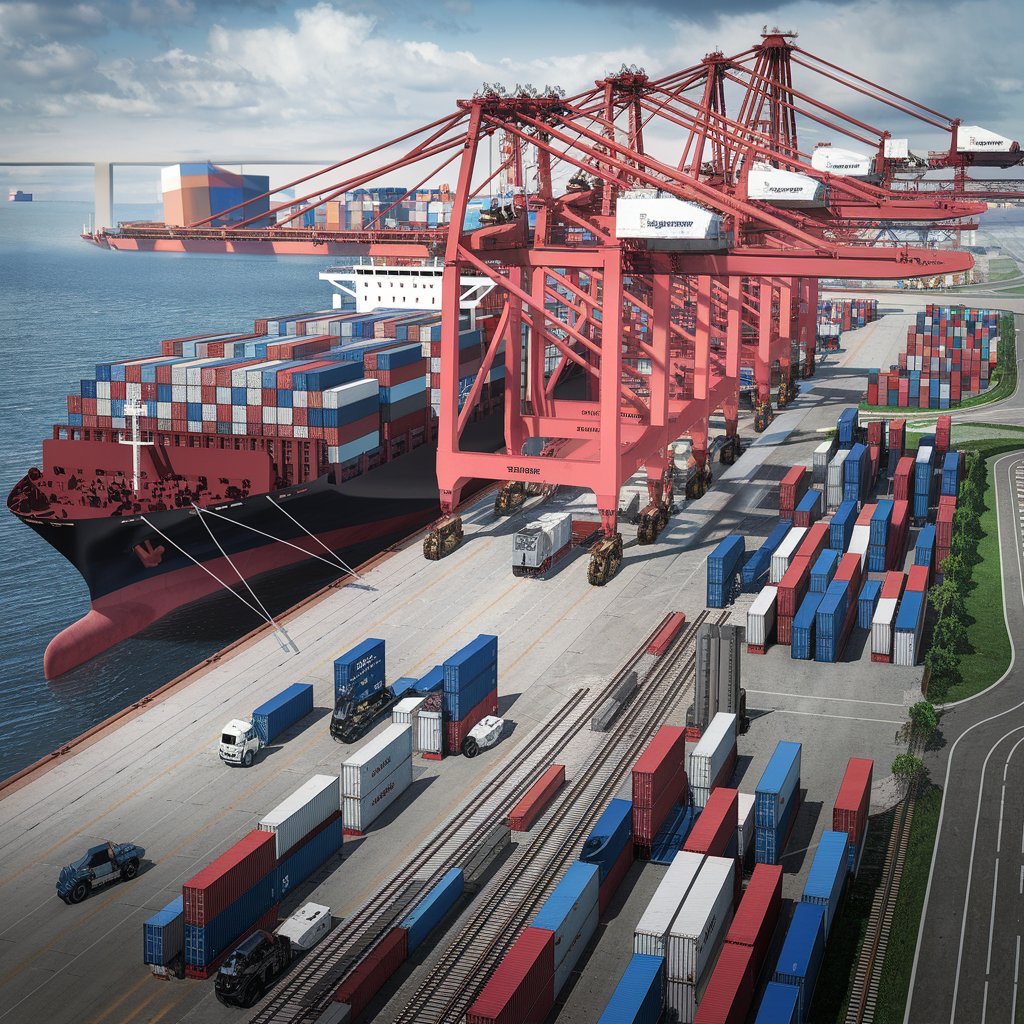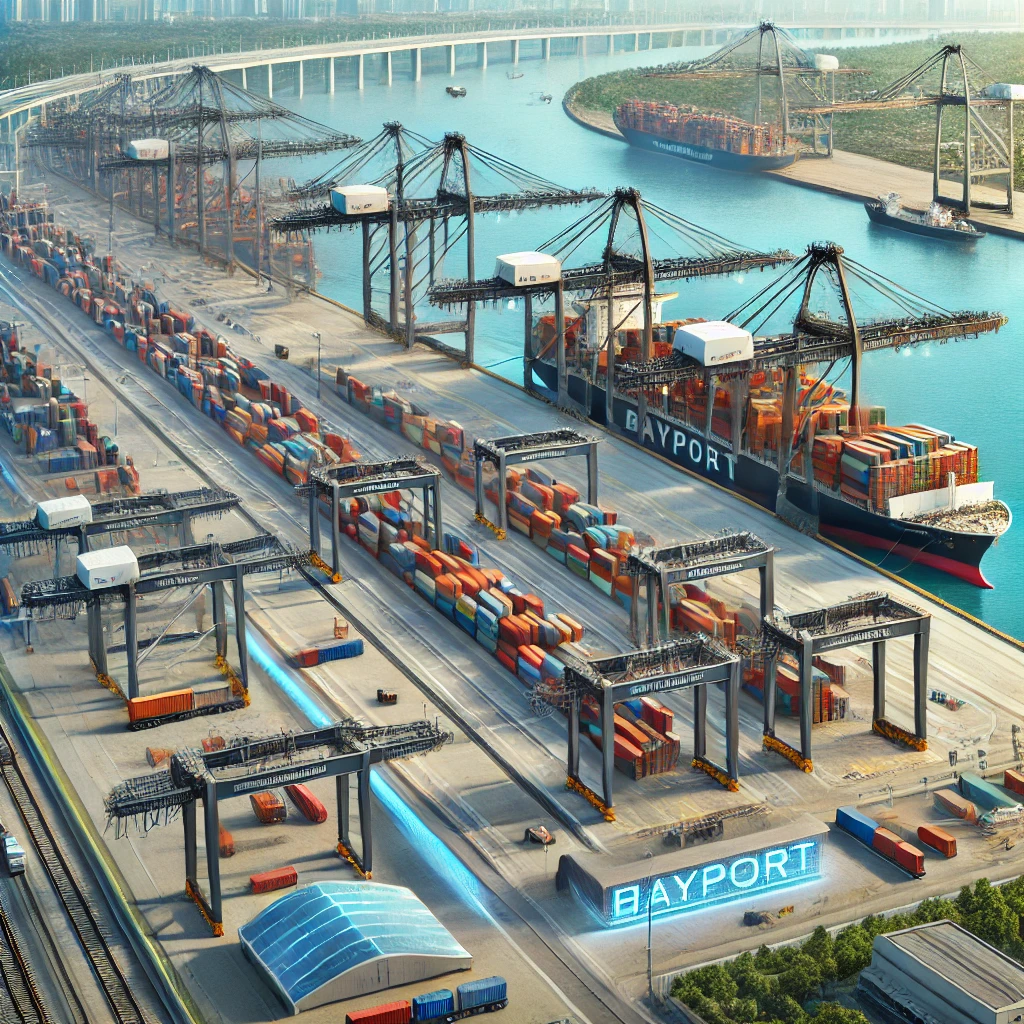Bayport Container Terminal: Unlocking the Potential of Gulf Coast Logistics

Overview of Bayport Container Terminal
Strategic Location
Situated in Pasadena, Texas, the Bayport Container Terminal enjoys a prime location that offers several advantages:
- Direct access to the Gulf of Mexico
- Proximity to major U.S. consumer markets
- Excellent connectivity to inland transportation networks
Key Statistics
- Annual container capacity: 2.3 million TEUs (Twenty-foot Equivalent Units)
- Terminal area: 376 acres
- Berth length: 3,300 feet
- Water depth: 40 feet, capable of handling post-Panamax vessels
State-of-the-Art Infrastructure
Advanced Equipment
Bayport Container Terminal boasts cutting-edge technology to ensure efficient operations:
- Super post-Panamax cranes
- Rubber-tyred gantry cranes (RTGs)
- Advanced container handling equipment
Terminal Operating System
The implementation of a sophisticated Terminal Operating System (TOS) has revolutionized Bayport’s operations, offering:
- Real-time container tracking
- Efficient yard management
- Streamlined gate processes
- Enhanced data analytics for performance optimization
Intermodal Capabilities
Bayport’s robust intermodal infrastructure includes:
- Near-dock rail facility
- Direct access to major highways (I-10, I-45, State Highway 146)
- Proximity to George Bush Intercontinental Airport
Navigating Bayport: A Guide for Shippers and Freight Forwarders
Pre-Arrival Procedures
- Documentation: Submit all required paperwork electronically through the terminal’s online portal.
- Customs Clearance: Coordinate with customs brokers to ensure smooth clearance processes.
- Container Release: Obtain necessary releases from shipping lines before pick-up.
Terminal Access
- TWIC Requirements: Ensure all drivers possess a valid Transportation Worker Identification Credential (TWIC).
- Truck Registration: Register trucks with the terminal’s Truck Registration System.
- Appointment System: Utilize Bayport’s appointment system for efficient container pick-ups and drop-offs.
Optimizing Dwell Time
- Free Time Management: Monitor free time allowances to avoid demurrage charges.
- Express Services: Take advantage of Bayport’s express services for faster cargo movement.
- Off-Peak Operations: Consider scheduling transactions during off-peak hours to reduce wait times.
Bayport's Commitment to Sustainability
Environmental Initiatives
Bayport Container Terminal is at the forefront of sustainable port operations:
- Implementation of electric rubber-tyred gantry cranes (E-RTGs)
- Use of ultra-low sulfur diesel fuel in terminal equipment
- Adoption of LED lighting across the facility
Green Port Practices
- Stormwater management and treatment systems
- Air quality monitoring and improvement programs
- Wildlife habitat conservation efforts
Challenges and Future Developments
Current Challenges
- Capacity Management: Addressing growing demand while maintaining operational efficiency.
- Weather Resilience: Enhancing infrastructure to withstand extreme weather events common in the Gulf Coast region.
- Technology Integration: Continuous adoption of new technologies to stay competitive.
Future Expansion Plans
Bayport has ambitious plans for growth:
- Berth expansion to accommodate larger vessels
- Implementation of semi-automated container handling systems
- Enhanced intermodal capabilities to improve inland connections

Leveraging Bayport for Supply Chain Optimization
Strategic Advantages for Shippers
- Market Access: Bayport offers quick access to major U.S. markets and Latin America.
- Operational Efficiency: Advanced technologies ensure fast turnaround times and reduced dwell times.
- Cost-Effectiveness: Competitive pricing and strategic location provide cost savings opportunities.
Best Practices for Freight Forwarders
- Develop Local Partnerships: Establish strong relationships with terminal operators and customs brokers at Bayport.
- Utilize Technology Platforms: Leverage Bayport’s digital systems for real-time tracking and efficient planning.
- Stay Informed: Keep abreast of Bayport’s operational updates and policy changes.

Case Studies: Success Stories at Bayport
Case Study 1: Automotive Parts Distributor
A major automotive parts distributor optimized their supply chain by:
- Utilizing Bayport’s express services
- Implementing just-in-time inventory management
- Leveraging the terminal’s intermodal connections
Results: 30% reduction in transit times and 20% cost savings.
Case Study 2: Chemical Exporter
A chemical exporter enhanced their operations through:
- Coordinating with Bayport’s dangerous goods handling team
- Utilizing the terminal’s specialized storage facilities
- Implementing Bayport’s advanced scheduling system
Results: Improved safety compliance and 25% increase in export volume.

Comparative Analysis: Bayport vs. Other Gulf Coast Terminals
Feature | Bayport Container Terminal | Other Gulf Coast Terminals |
Container Capacity | 2.3 million TEUs | Varies (generally lower) |
Water Depth | 40 feet | 35-45 feet |
Intermodal Connectivity | Excellent | Good to Excellent |
Technology Integration | Advanced | Varies |
Sustainability Initiatives | Comprehensive | Varies |

Future Trends Impacting Bayport and Gulf Coast Logistics
- Increased Automation: Implementation of AI and machine learning for predictive maintenance and operational optimization.
- Shift in Trade Patterns: Potential increase in Asia-Gulf Coast trade due to Panama Canal expansion.
- E-commerce Growth: Rising demand for efficient handling of small parcel shipments.
- Blockchain Integration: Potential adoption of blockchain technology for enhanced transparency and security.
Conclusion
The Bayport Container Terminal stands as a pivotal hub in Gulf Coast logistics, offering unparalleled advantages for businesses engaged in international trade. By understanding and leveraging Bayport’s capabilities, infrastructure, and strategic location, shippers and freight forwarders can significantly optimize their supply chains, reduce costs, and improve overall efficiency.
As Bayport continues to evolve and expand, it remains committed to providing world-class service while embracing sustainability and technological innovation. For logistics professionals seeking to navigate the complexities of global trade, Bayport Container Terminal offers a strategic gateway that combines location, technology, and expertise.
By capitalizing on the resources and capabilities of Bayport, businesses can gain a competitive edge in the dynamic landscape of Gulf Coast logistics. As trade patterns continue to shift and evolve, Bayport’s role in facilitating efficient, cost-effective, and sustainable supply chains will only grow in importance.
